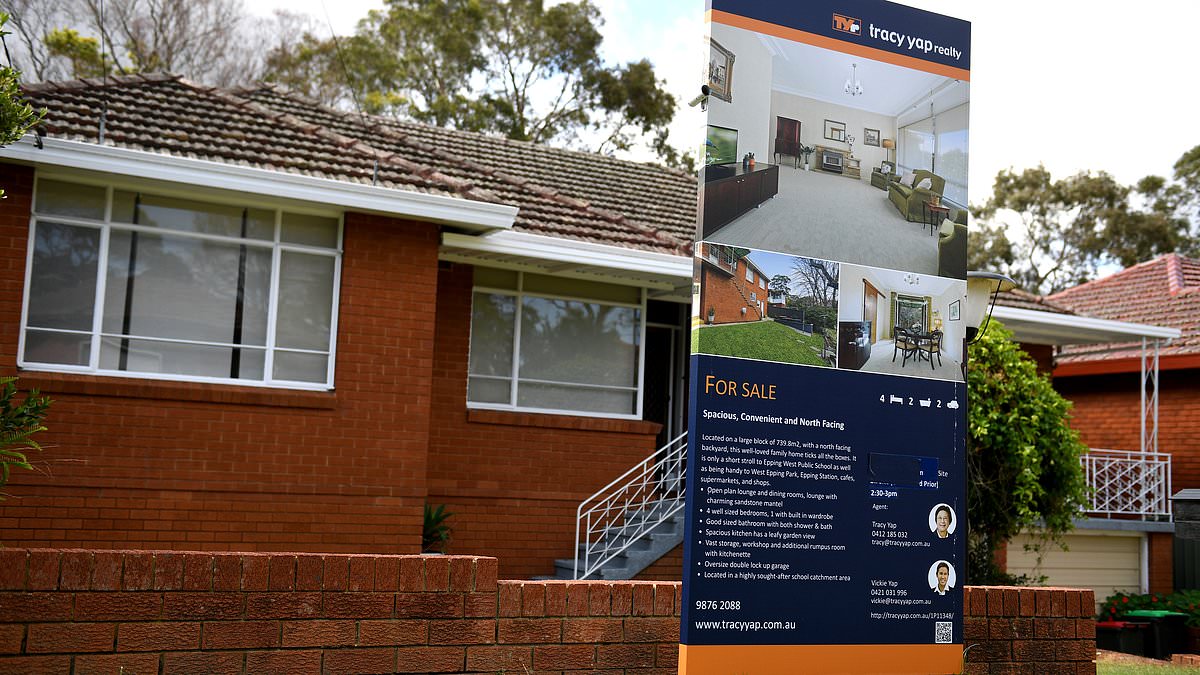Property prices in Sydney and Melbourne have declined as the number of overseas visitors drops with an immigration slowdown expected to cut prices further.
Real estate group CoreLogic says a drop in permanent and long-term overseas arrivals from record-high levels will spark a slowdown, especially in markets that have become too unaffordable.
‘Less migration is likely to flow through to a further easing in rental demand, and, over the medium term, reduced demand for home purchasing,’ CoreLogic said.
Hobart, which doesn’t receive a big influx of overseas or interstate migration, also went backwards in 2024 while Perth, Brisbane and Adelaide last year reached new heights with double-digit annual growth.
Sydney’s median house price has now declined for three straight months since peaking in September, falling by 1.6 per cent during the December quarter to $1.471million.
Melbourne’s mid-point house price did even worse, diving by 1.8 per cent during the final three months of 2024 to $917,616, making it ‘s fourth most expensive capital city market after Sydney, Brisbane and Canberra despite having ‘s second highest population.
The Victorian capital had the worse annual decline of 2.9 per cent in 2024, having peaked in March 2022 before the Reserve Bank rate rises, only to get hit last year with a $975 state government land tax on investors.
Sydney prices last year went up by just 2.5 per cent – after enjoying double-digit annual growth as recently as March.
The drop or slowdown in house prices, in ‘s two biggest cities, occurred as immigration levels moderated from record-high levels.
During the last financial year, 445,600 migrants moved to , marking a big drop from an all-time high of 548,800 in the year to September 2023.
Sydney and Melbourne are housing the majority of new overseas migrants with 61.8 per cent of them moving to New South Wales or Victoria.
By October, ‘s net overseas migration level was hovering at 448,090 arrivals.
But Treasury is expecting that intake to slow to 340,000 by June 2025, last month releasing new forecasts in its Mid-Year Economic and Fiscal Outlook.
Treasury’s Population Statement forecast ‘s annual population growth declining from 2.1 per cent in 2023-24 to 1.2 per cent by 2034-35 ‘as net overseas migration moderates’.
‘This will reflect a decline and subsequent stabilisation of arrivals, and a pick-up in departures,’ it said.
The states that had a bigger inflow of interstate migrants still performed strongly in late 2024.
Perth’s median house prices last year climbed by 18.7 per cent to $847,518, and by 1.7 per cent over the December quarter, with Western having the nation’s strongest population growth pace of 2.8 per cent.
Brisbane’s mid-point house prices soared by 10.2 per cent to $977,575 and by 1.1 per cent during the final three months of 2024.
Adelaide’s equivalent house price rose by 12.5 per cent over the year to $866,327, and by 2 per cent over the quarter, despite South having weaker population growth.
Parts of outer south-west Sydney are still growing strongly with Fairfield Heights seeing its median house price last year soar by 12.6 per cent to $1.112million.
But in beachside Cronulla, the mid-point house prices last year fell by 8.6 per cent to $2.708million.
Other capitals with weaker population growth did badly last year with Hobart’s mid-point house price slipping by 0.5 per cent last year to $693,924.
The Tasmanian capital peaked in March 2022 when the RBA cash rate was still at a record-low of 0.1 per cent.
Canberra, an expensive market with below-average population growth, saw its median house price decline by 0.3 per cent during the December quarter to $965,910, for a weak annual growth pace of 0.4 per cent.
The national capital peaked in May 2022, the month the Reserve Bank raised interest rates for the first time since 2010.
CoreLogic’s research director Tim Lawless said house prices were falling in cities that had become too unaffordable.
‘This result represents the housing market catching up with the reality of market dynamics,’ he said.
‘Growth in housing values has been consistently weakening through the second half of the year, as affordability constraints weighed on buyer demand and advertised supply levels trended higher.’
House and unit prices across last year grew by 4.9 per cent, but they fell by 0.1 per cent in December, marking the first national monthly drop since January 2023.
Mr Lawless said rate cuts alone would be insufficient to kickstart activity in the weaker property markets unless the n Prudential Regulation Authority, which oversees the banks, relaxed lending rules.
Lenders have been required, since late 2021, to factor in a potential borrower’s ability to cope with a three percentage point increase in variable mortgage rates.
SYDNEY: Up 2.5 per cent annually but down 1.6 per cent in December quarter to $1.47million
MELBOURNE: Down 2.9 per cent annually and down 1.8 per cent in December quarter to $917,616
BRISBANE: Up 10.2 per cent annually and up 1.1 per cent in December quarter to $977,575
PERTH: Up 18.7 per cent annually and 1.7 per cent in December quarter to $847,518
ADELAIDE: Up 12.5 per cent annually and 2 per cent in December quarter to $866,327
HOBART: Down 0.5 per cent annually but up 0.6 per cent in December quarter to $693,924
CANBERRA: Up 0.4 per cent annually but down 0.3 per cent in December quarter to $965,910
DARWIN: Up 1.4 per cent annually and up 0.2 per cent in December quarter to $586,699
Source: CoreLogic data for December 2024
